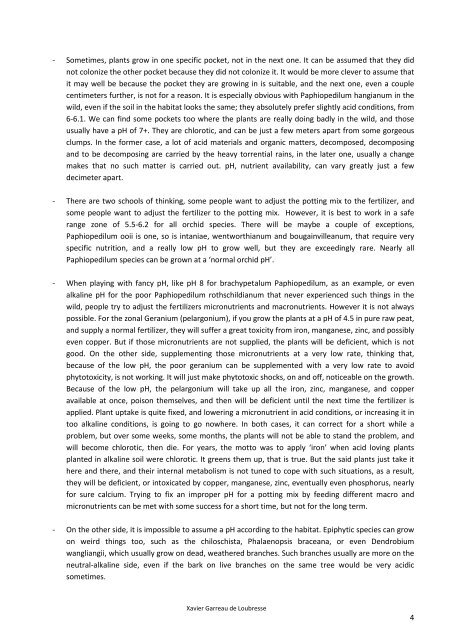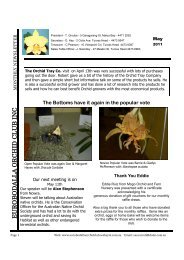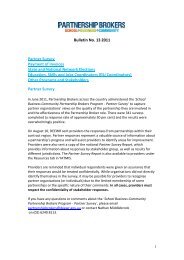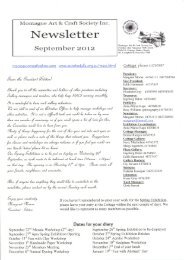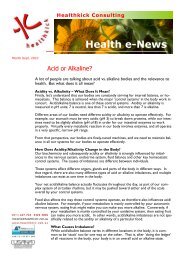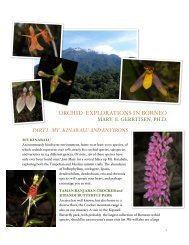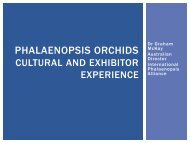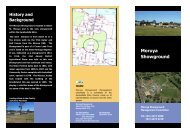Orchid Growing Substrates
Orchid Growing Substrates
Orchid Growing Substrates
You also want an ePaper? Increase the reach of your titles
YUMPU automatically turns print PDFs into web optimized ePapers that Google loves.
- Sometimes, plants grow in one specific pocket, not in the next one. It can be assumed that they did<br />
not colonize the other pocket because they did not colonize it. It would be more clever to assume that<br />
it may well be because the pocket they are growing in is suitable, and the next one, even a couple<br />
centimeters further, is not for a reason. It is especially obvious with Paphiopedilum hangianum in the<br />
wild, even if the soil in the habitat looks the same; they absolutely prefer slightly acid conditions, from<br />
6-6.1. We can find some pockets too where the plants are really doing badly in the wild, and those<br />
usually have a pH of 7+. They are chlorotic, and can be just a few meters apart from some gorgeous<br />
clumps. In the former case, a lot of acid materials and organic matters, decomposed, decomposing<br />
and to be decomposing are carried by the heavy torrential rains, in the later one, usually a change<br />
makes that no such matter is carried out. pH, nutrient availability, can vary greatly just a few<br />
decimeter apart.<br />
- There are two schools of thinking, some people want to adjust the potting mix to the fertilizer, and<br />
some people want to adjust the fertilizer to the potting mix. However, it is best to work in a safe<br />
range zone of 5.5-6.2 for all orchid species. There will be maybe a couple of exceptions,<br />
Paphiopedilum ooii is one, so is intaniae, wentworthianum and bougainvilleanum, that require very<br />
specific nutrition, and a really low pH to grow well, but they are exceedingly rare. Nearly all<br />
Paphiopedilum species can be grown at a ‘normal orchid pH’.<br />
- When playing with fancy pH, like pH 8 for brachypetalum Paphiopedilum, as an example, or even<br />
alkaline pH for the poor Paphiopedilum rothschildianum that never experienced such things in the<br />
wild, people try to adjust the fertilizers micronutrients and macronutrients. However it is not always<br />
possible. For the zonal Geranium (pelargonium), if you grow the plants at a pH of 4.5 in pure raw peat,<br />
and supply a normal fertilizer, they will suffer a great toxicity from iron, manganese, zinc, and possibly<br />
even copper. But if those micronutrients are not supplied, the plants will be deficient, which is not<br />
good. On the other side, supplementing those micronutrients at a very low rate, thinking that,<br />
because of the low pH, the poor geranium can be supplemented with a very low rate to avoid<br />
phytotoxicity, is not working. It will just make phytotoxic shocks, on and off, noticeable on the growth.<br />
Because of the low pH, the pelargonium will take up all the iron, zinc, manganese, and copper<br />
available at once, poison themselves, and then will be deficient until the next time the fertilizer is<br />
applied. Plant uptake is quite fixed, and lowering a micronutrient in acid conditions, or increasing it in<br />
too alkaline conditions, is going to go nowhere. In both cases, it can correct for a short while a<br />
problem, but over some weeks, some months, the plants will not be able to stand the problem, and<br />
will become chlorotic, then die. For years, the motto was to apply ‘iron’ when acid loving plants<br />
planted in alkaline soil were chlorotic. It greens them up, that is true. But the said plants just take it<br />
here and there, and their internal metabolism is not tuned to cope with such situations, as a result,<br />
they will be deficient, or intoxicated by copper, manganese, zinc, eventually even phosphorus, nearly<br />
for sure calcium. Trying to fix an improper pH for a potting mix by feeding different macro and<br />
micronutrients can be met with some success for a short time, but not for the long term.<br />
- On the other side, it is impossible to assume a pH according to the habitat. Epiphytic species can grow<br />
on weird things too, such as the chiloschista, Phalaenopsis braceana, or even Dendrobium<br />
wangliangii, which usually grow on dead, weathered branches. Such branches usually are more on the<br />
neutral-alkaline side, even if the bark on live branches on the same tree would be very acidic<br />
sometimes.<br />
Xavier Garreau de Loubresse<br />
4


